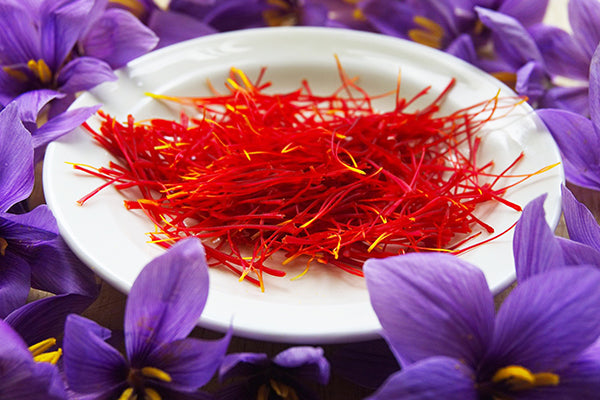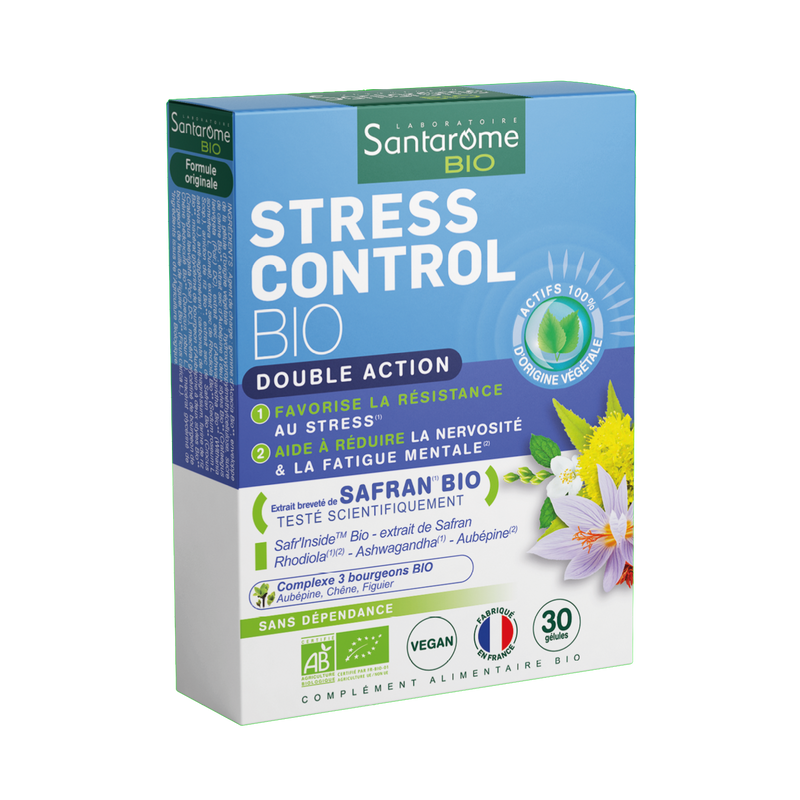The benefits of Saffron
Write the 17/02/2023 by Santarome Bio
What is saffron?
Saffron is a spice known for its hair form and as a flavor enhancer. This spice belongs to the Iridaceae family and its species is Crocus Sativus. This bright red flower is full of three stigmas, whose active ingredients are well known to act against stress, the blues and even premenstrual symptoms. These stigmas are attached to a bulb-shaped stem called the corm, and surrounded by purple-colored petals. The stigmas of saffron are dried in order to release the therapeutic virtues attributed to it. They are also mainly used in cooking as condiments or food coloring.
This spice is commonly called red gold because its price varies according to the price of gold. It is one of the most expensive on the market due to its long and laborious production. Saffron has carotenoid, crocin and safranal components. Saffron is often harvested during the winter because it loses its leaves when spring appears.

History and habitat
Saffron was first discovered in the Greek regions before being cultivated and exploited in turn in the Middle East.
During ancient Egypt, saffron was used to cure the aches and pains of the population. It was also considered an aphrodisiac that Cleopatra poured into her bath. The medicinal effects of this flower subsequently became a tradition in several Asian countries. It was used to treat respiratory infections (coughs, colds, asthma) but also to combat stress and indigestion. Today, this “red gold” is still used for its medicinal and curative benefits.
This bright red flower grows in well-drained, low-moisture, even arid soils. It prefers places exposed to sunlight and does not tolerate shade with difficulty. Storms and rains reduce the quality of production. The main producers of saffron are Greece, Morocco and several countries in the Middle East, but Iran is the country that by far dominates the saffron market as it is a widely used spice in Persian cuisine. Other European countries such as France or Spain have also decided to cultivate this “red gold”.
Properties and benefits of saffron
For millennia, saffron has been used to remedy the most complex health problems:
-
Powerful antioxidant : saffron is known for its antioxidant effects because the saffron flower contains crocin, carotenoids, as well as safranal which act against cell aging, in interaction with the air.
Powerful anti-inflammatory : it is also an excellent way to fight all types of infections. To combat tooth pain, the use of saffron is very useful. The same goes for ear infections or joint pain. It greatly reduces post-menstrual symptoms (headaches, stomach cramps) but also symptoms due to menopause (hot flashes).
-
Reduces symptoms of depression and stress : The main use of saffron is to combat stress and depression. Safranal has antidepressant active ingredients which act on the nervous system and lead to emotional balance. In addition, it reduces sleep disturbances and thus influences mood.
Anti-cancer properties : saffron carotenoids have positive properties for slowing the development of cancer. It was also formerly used for this purpose.
Digestive properties : saffron promotes digestion and cleanses the liver. In addition, it reduces the appetite by giving a feeling of satiety.
-
Positively influences diabetes and triglycerides : the qualities of saffron have been shown to reduce blood sugar levels and cholesterol levels. It thus improves the health of people with triglycerides and diabetes and therefore reduces cardiovascular risks.
Corrects vision : the benefits of saffron also help fight against the degeneration of retinal tissues. This spice also benefits the visual system of the elderly, in order to stabilize cataract problems.
-
Improves the memory of people suffering from degenerative diseases : the crocus has shown its prowess regarding the deterioration of the neurons of people suffering from degenerative diseases such as Alzheimer's disease. In addition, it neutralizes and improves the cognitive abilities of these people and those suffering from attention disorders and hyperactivity.
Effects on sexual health : saffron is a powerful aphrodisiac that Cleopatra used in her bath. It leads to desire and promotes erection in men.
Restores energy and vitality : thanks to the active ingredients of saffron, its properties combat fatigue and are an energy booster. It increases sports performance and endurance.
-
Benefits for the skin : saffron helps slow down the aging of cells, which is why it is often included in the composition of pharmaceutical and cosmetic products.
How to consume it + dosage
Saffron can be consumed in different ways:
Powder,
Excerpts,
Infusions,
Tablets / capsules,
Light bulbs.
The recommended daily dose for consuming saffron is 30 mg. A dose greater than 1.5g per day may cause undesirable effects.
The Stress Control Bio ampoules from Santarome Bio bring together all the necessary active ingredients of saffron for serenity.
Our 4-plant formula is limited to 1 ampoule per day, diluted in a glass of water (20cl), to take for 20 days.
Side effects/Precautions for use
Saffron has no side effects. However, it is not recommended for pregnant or breastfeeding women, children under 12 years old, and people taking antihypertensive or antidepressant treatment. In case of overdose, it may cause vomiting or gastrointestinal problems. It is therefore advisable to follow the doses exactly.

















